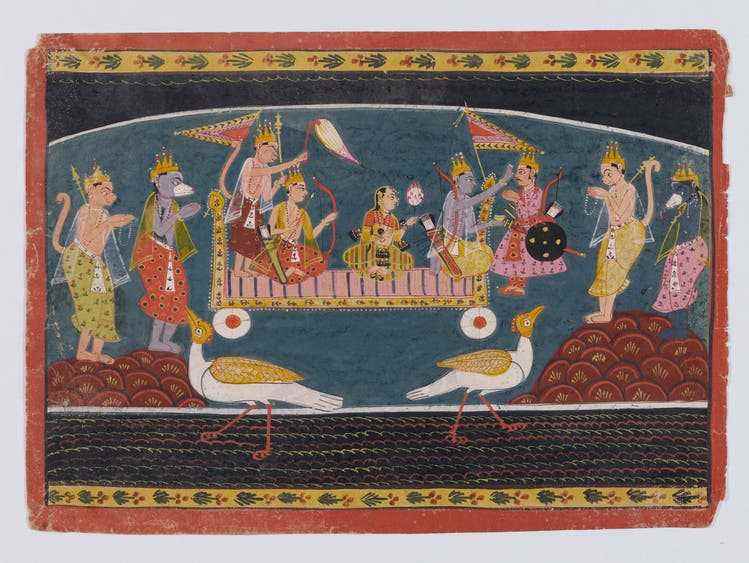Colors can also be tasted – this is shown by a remarkable exhibition in the Museum Rietberg.
The miniatures with stories about the gods of the Hindus, which were donated to the Museum Rietberg, open a new chapter in the rich holdings of Indian painting.
Every day we experience how an abundance of color sensations affects our mind: appellative, soothing, stimulating. Colors combine with moods and create a sense of well-being. They are a mobile medium and oscillate back and forth between eye, nose and feeling. You don’t have to be a synesthete to imagine that you can taste colors. Sometimes you can even taste them like food – and what would food be without color?
Taste plays an important role in the aesthetic theory of India. It is rasa and means an increased aesthetic feeling that encompasses all the senses. The term means a kind of essence, an aesthetic aroma, a rapture of the mind, a felt knowledge that gives deep satisfaction. All arts are united in Rasa – from drama to music to fine arts. It also includes the art of living. So a good meal, in which all the ingredients combine into a single sensation, can be rasa. The taste experience becomes a transcendent experience.
For Konrad Seitz, the color fields in Indian painting are the actual centers of the pictures. The energy of the pictorial narrative is concentrated in these empty fields, which are only filled with color. In fact, the colors in the miniatures of the diplomat and researcher’s collection are of the highest brilliance. They are landscape, sky, mood, symbol. The passion of the lovers is reflected in the red of the chamber, the distance that separates the wanderer from his beloved in the blue of the river. The whole abundance of nature is contained in the green. So the color is not just an ingredient in the pictorial narrative, but an active player.
Tales of the Gods of the Hindus
The miniatures in the Eva and Konrad Seitz collection open a new chapter in the rich holdings of Indian painting in the Rietberg Museum in Zurich. The 48 paintings now on display are part of the gift the couple made to the museum. Seitz was the German ambassador to India and built up an impressive collection in addition to his civil service. But not only the beauty of the paintings fascinated him, he also wanted to do something for research. His writings on art at the courts of the Bundelkhand region set new standards and revised some findings.


Classic Hindu motifs mixed with influences of Mughal culture in these sheets.
Bundelkhand is located in the upper third of the Indian subcontinent. Classic Hindu motifs mixed there with influences of Mughal culture. The themes of the pictures almost all come from the stories of the gods of the Hindus and are often evidence of a lived popular piety. The tales of Krishna are part of the popular repertoire, as are the ragamalas, music and poetry transposed into images. But what distinguishes the pictures in the Seitz Collection from the elaborate styles of the 18th century is a certain archaic quality.
The miniatures were mostly created in the 17th and at the transition to the 18th century; they belong to the early phase of Indian painting. At first glance, they have something heraldic about them: bright color contrasts, shallow spatial depth, few interior details. Figures and ornaments are stylized, comparable to archaic Greek vase painting. They also have the formal ciphers for the eyes of the figures in common with this. These are shown frontally on the faces, which are always painted in profile. The traits of the figures are symbolic overall, individual recognition is reduced to attributes and actions.
Archaic Comics
The paintings from Bundelkhand have nothing primitive about them. They, too, are elaborate in terms of painting technique and are often astonishingly bold. One could almost speak of an abstraction of the pictorial narrative. The figures act in geometrically simplified pictorial spaces and ciphers, a world that depicts the theater of gods, people and animals as if on a stage. This also corresponds to the serial readability of the images. Entire stories are sometimes painted on a single sheet like an archaic comic.


Like comics, these images tell of human passions.
In such images, the derivation of rasa from the theater becomes clear. The embodiment of the feeling is the aim of the representation. With the transfer to the painting, the viewer of the pictures should participate in the state of being enraptured. The fact that the sheets were celebrated in selected circles and then closed again in folders was not just a distraction, but a ritual based on religion.
The rapture that is evoked by a work of art alone is difficult for us today to comprehend. And yet there is a spiritual experience behind it, as it exists in all cultures. In addition, the pictures often tell quite simply about human passions. The longing for the beloved has always remained the same throughout the ages, and the river on which the lover walks diagonally through the picture is also the flow of life between happiness and sadness.

Colors of great radiance: such miniatures belong to the earliest phase of Indian painting.
devotion and longing. The Eva and Konrad Seitz Collection. Museum Rietberg, until October 3rd.
